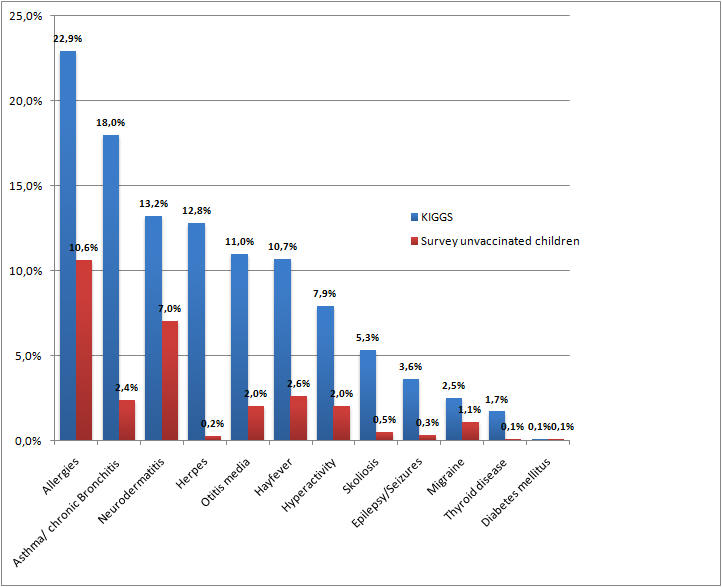
Vaccinated children have up to 500% more disease than unvaccinated children
Suspicions have been confirmed for those wary of vaccinating
their children. A recent large study corroborates other independent study
surveys comparing unvaccinated children to vaccinated children.
They all show that vaccinated children have two to five times more childhood
diseases, illnesses, and allergies than unvaccinated children.
Originally, the recent still ongoing study compared unvaccinated children
against a German national health survey conducted by KiGGS involving over 17,000
children up to age 19. This currently ongoing survey study was initiated by
classical homoeopathist Andreas Bachmair.
However, the American connection for Bachmair's study can be found at
VaccineInjury.info website that has added a link for parents of vaccinated
children to participate in the study. So far this ongoing survey has well over
11,000 respondents, mostly from the U.S.A. Other studies have surveyed smaller
groups of families.
Nevertheless, the results were similar. Of course, none of these studies were
picked up by the MSM (mainstream media). None were funded by the Centers for
Disease Control and Prevention (CDC) or the World Health Organization (WHO) or
any national or international health agency or medical profession group (http://healthimpactnews.com).
They don't dare compare the health of unvaccinated children to vaccinated
children objectively and risk disrupting their vaxmania (vaccination mania). The
focus for all the studies was mostly on childhood illnesses occurring as the
children matured.
Dramatic, debilitating, or lethal vaccine injuries were not the focus since so
few, five percent or less, actually get reported to VAERS (Vaccine Adverse
Injury Reporting System) in the U.S.A. for various reasons including:
* It's a complicated system that takes time from a doctor's practice.
* Most parents don't know about it.
* Only adverse reactions that occur immediately after vaccinations are
considered.
* Since VAERS is voluntary, most doctors don't want to incriminate themselves
with vaccination injuries and maintain their denial of vaccine dangers.
Consequently, even the most terrible adverse reactions are minimally
acknowledged, while long term negative health issues resulting from vaccines are
not even considered relevant.
Different surveys summarized
The childhood diseases usually posed to respondents by the independent surveys
involved asthma, reoccurring tonsillitis, chronic bronchitis, sinusitis,
allergies, eczema, ear infections, diabetes, sleep disorders, bedwetting,
dyslexia, migraines, hyperactivity, ADD, epilepsy, depression, and slower
development of speech or motor skills.
In 1992, a New Zealand group called the Immunization Awareness Society (IAS)
surveyed 245 families with a total of 495 children. The children were divided
with 226 vaccinated and 269 unvaccinated. Eighty-one families had both
vaccinated and unvaccinated children.
The differences were dramatic, with unvaccinated children showing far less
incidence of common childhood ailments than vaccinated children
(http://www.vaccineinjury.info/images/stories/ias1992study.pdf).
From a different survey in the South Island New Zealand city of Christchurch,
among children born during or after 1977, none of the unvaccinated children had
asthma events where nearly 25% of the vaccinated children were treated for
asthma by age 10
http://www.vaccineinjury.info/images/stories/ias1992study.pdf
Many of the comments from non-vaccinating parents to VaccineInjury.info for the
ongoing Bachmair survey mentioned vaccination danger and developing true
immunity naturally were concerns
A PhD immunologist who wrote the book Vaccine Illusion, Dr. Tetyana Obukhanych,
has gone against the dogma of her medical training and background.
She asserts that true immunity to any disease is not conferred by vaccines.
Exposure to the disease, whether contracted or not, does
http://www.vaccinationcouncil.org
Perhaps the most informal grass-roots survey going on now is by Tim O'Shea, DC,
author of Vaccination is Not Immunization. He simply has non-vaccinating parents
email him with comparisons of their children's health to friends and families
they know with vaccinated children.

The results of our survey with currently 11670 participants show that
unvaccinated children are far less affected by common diseases than vaccinated
children. Due to the fact that the majority of children in the survey are
between 0 and 2 years of age and some diseases generally do not appear in this
age group, the results are subdivided into different age groups (you can see
that by clicking on the chart). Information about country, gender, age, age
distribution, breastfeeding, preferred treatment can be found here.
Atopic diseases among unvaccinated children
Asthma, hayfever and neurodermatitis are seen very frequently today. A recent
German study with 17461 children between 0-17 years of age (KIGGS) showed that
4.7% of these children suffer from asthma, 10.7% of these children from hayfever
and 13.2% from neurodermatitis. These numbers differ in western countries, i.e.
the prevalence of asthma among children in the US is 6% whereas it is 14-16% in
Australia (Australiaís Health 2004, AIHW)
The prevalence of asthma among unvaccinated children in our study is around
2.5%, hayfever 3% and neurodermatitis 7%.
According to the KIGGS study more than 40% of children between the ages of 3 and
17 years were sensitized against at least one allergen tested (20 common
allergens were tested) and 22.9% had an allergic disease. Although we did not
perform a bloodtest, around 10% stated that their children had an allergy.
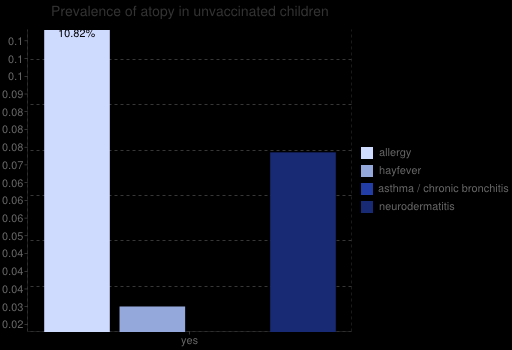
If you want to compare the results with the results of the survey on our
German website impfschaden.info go here.
ADS, Hyperactivity, Autism, Sleeping problems, concentration problems and
migraine
ADS and Hyperaktivity is between 1 and 2 % in our survey, the prevalence of ADHD
in Germany is 7,9% and another 5,9% which were not yet diagnosed, but were
borderline cases(KIGGS).
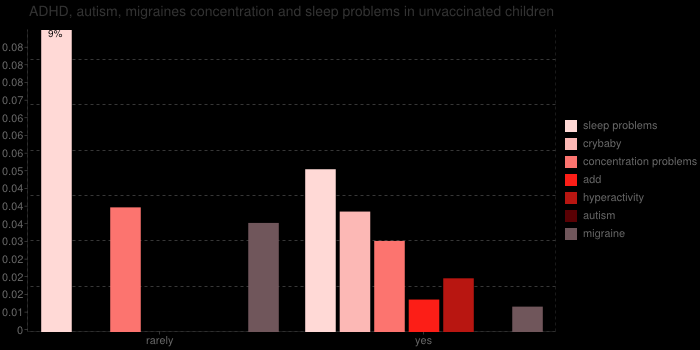
There are also autism cases in unvaccinated children. Among all participants
there were 4 severe autism cases.
Of these 4 children one tested very high for metals(mercury, aluminum, arsenic),
in another case the mother was tested very high for mercury.
The CDC estimates that about 1 in 88 (1,1%) children has been identified with an
autism spectrum disorder (ASD)(Autism and Developmental Disabilities Monitoring
(ADDM) Network). ASDs are almost 5 times more common among boys (1 in 54; 1,8%)
than among girls(1 in 252;0,39%).(Jon Baio, Prevalence of Autism Spectrum
Disorders ó Autism and Developmental Disabilities Monitoring Network, 14 Sites,
United States, 2008, March 30, 2012 / 61(SS03);1-19)
Otitis media, Sinusitis, Herpes, Warts, Polyps and fungal infections
KIGGS showed that 12.8% of the children in Germany had herpes and 11% suffer
from otitis media (an inflammation of the middle ear). If you compare this to
unvaccinated childen you can see that herpes among unvaccinated children is very
rare (less than 0.5%).
The prevalence of sinusitis in young children has gone up as high as 32% (Albegger
KW. Banale EntzŁngen der Nase und der NasennebenhŲhlen. In: Berendes J, Link JR,
ZŲllner F, eds. Hals, Nasen-,OhrenHeilkunde in Praxis und Klinik. Band I. Obere
und untere Luftwege. Stuttgart: G Thieme Verlag, 1979: 11.1Ė11.32.)
In our survey less than 1% of the children have problems with sinusitis, in
around 2% it happened only once or rarely.
In young kids under the age of 3 warts are very rare. Above the age of three
years however the prevalence is rising. In the ages between 4 and 6 years, 5-10%
of the kids have warts, in the age group 16-18, 15-20% have warts.(http://www.netdoktor.at/health_center/dermatologie/warzen.htm)
Only 3% of unvaccinated children in our survey have warts.
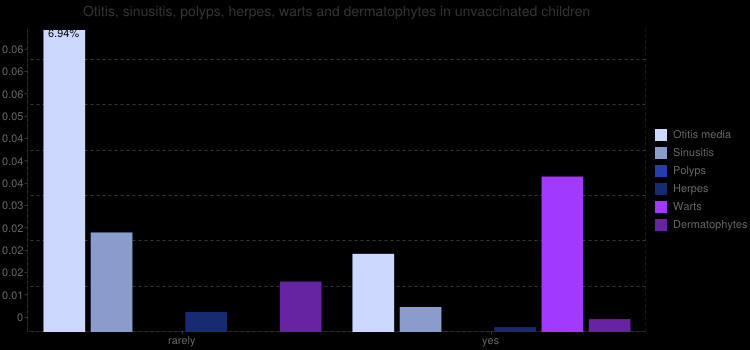
Fine motor skill problems, dentificvation problems, growth pains and scoliosis
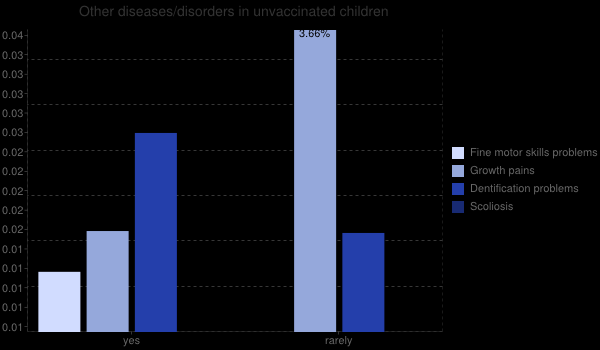
Diabetes, Epilepsy and seizures, neurological and autoimmune diseases,
thyroid disorders
The national institute of health in the USA states that 23.5 % Americans suffer
from autoimmune disease. This is a prevalence of more than 7% of children.
Diabetes affects 0.2% of the children under 20 years of age in the USA (National
Diabetes Fact Sheet)
The KIGGS study showed prevalences of epilepsy with 3.6%, prevalence of Diabetes
in Germany with 0.1% and diseases of the thyroid gland with 1.7%.
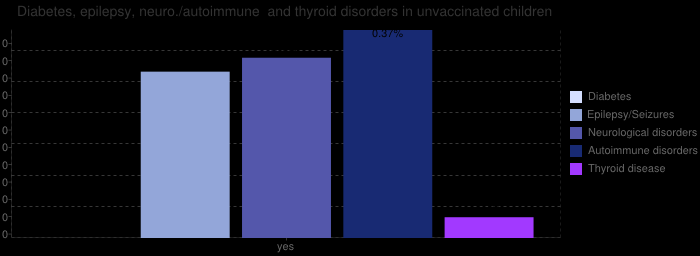
Other disorders and diseases
As we included open questions in our survey we evaluated the prevalence (of the
first 10070 participants) of some other disorders and illnesses. Unvaccinated
children show very low prevalences of the following disorders:
Dyslexia 0,21%
Speech delay/articulation problems 0,38%
Sensory Processing disorder 0,28%
Anxiety 0,25%
Depression 0,12%
Bedwetting 0,12%
Celiac disease 0,12%
Gluten sensitivity 0,41%
GERD (Gastroesophageal reflux disease) 0,06%
Direct comparison KIGGS study (and other studies) and vaccineinjury.info-survey
(July 2012)
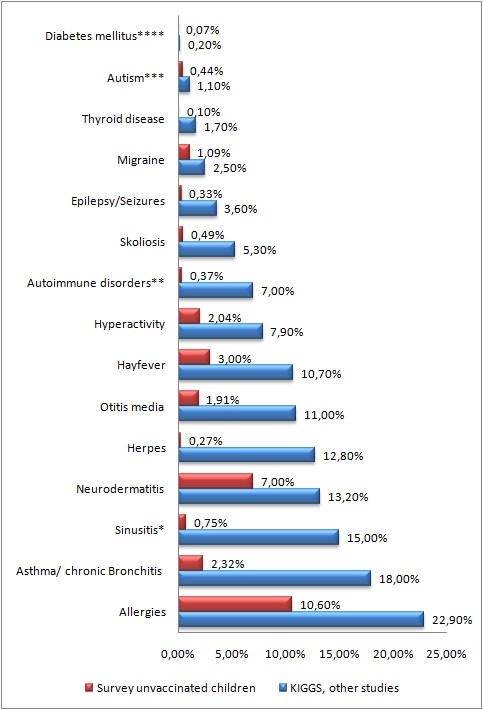
The data was collected from parents with vaccine-free children via an
internet questionnaire by vaccineinjury.info and Andreas Bachmair, a German
classical homeopathic practitioner. The website is not a pretty one (including
Google ads for vaccines) but the actual data is what counts. The independent
study is self-funded and is not sponsored by a large ďcredibleĒ non-profit or
government health organization with political and financial conflicts of
interest. Each one of the 8000 cases are actual cases with medical documentation.
Three other studies had similar results according to Bachmair and are reported
below.
No study of health outcomes of vaccinated people versus unvaccinated has ever
been conducted in the U.S. by CDC or any other agency in the 50 years or more of
an accelerating schedule of vaccinations (now over 50 doses of 14 vaccines given
before kindergarten, 26 doses in the first year). Most data collected by CDC is
contained in the Vaccine Adverse Event Reporting System (VAERS) database. The
VAERS is generally thought to contain only 3 to 5 percent of reportable
incidents. This is simply because only some immediate reactions are reported by
doctors; but many are not admitted to be reactions to the vaccine. Most
importantly, the VAERS numbers are only immediate reactions, which I would place
with a few hours to a few weeks. Long-term vaccine-induced diseases and
disorders are not recognized by parents or doctors when these conditions develop
perhaps a few months to five years or more and would never be realized to come
from multiple vaccinations. In other words, many children and adults have
diseases and disorders that are vaccine induced and they never suspect they are
from the vaccines, as this study indicates.
But if we want to compare these results to the claims that vaccinated children are healthier made in 1992, just read this article.

There are no controlled experiments that study the health outcomes of
unvaccinated versus vaccinated people even though there are an estimated 50,000
totally unvaccinated people living in the US. In The Greater Good, our
government officials state that they donít think these studies would be
worthwhile and that a better use of our limited research dollars should go to
developing the next vaccine. Hearing that really disturbed me. Especially
considering the following:
Most vaccines contain controversial ingredients, such as polysorbate,
formaldehyde, monkey kidney cells, aluminum and mercury. Some of these
ingredients are especially dangerous to babies. For example:
Mercury is known to be toxic to the brain and body tissues. The manufacturers
claim that the dosage in vaccines is small, but when combined with the mercury
that weíre getting from environmental sources, it may very well be enough to
push our bodies (especially the fragile body of an infant) over the limit. While
most manufacturers have cut back on the level of mercury in their vaccines, some
brands of the flu shot and a few older versions of the plain tetanus and
diphtheria/tetanus shots still contain high levels of mercury, so itís best to
ask for a mercury-free brand if you plan to get those vaccinations.
Aluminum is replacing mercury as the main adjuvant in many vaccines today,
including Hib, Hepatitis B, DTaP and the new HPV vaccine. The injectable form of
aluminum thatís used in vaccines is different from dietary aluminum. These
studies, conducted by Dr. Chris Shaw, showed that when mice are injected with
aluminum in a way that mimics the doses one would get by following the USís
recommended vaccine schedule, they have cognitive and behavioral problems and
damage to the part of the brains that control motor function. According to Hugh
Fudenberg, MD, the worldís leading immunogeneticist and 13th most quoted
biologist of our times: ďIf an individual has had 5 consecutive flu shots
between 1970 and 1980 (the years studied) his/her chances of getting Alzheimerís
Disease is 10 times higher than if he/she had one, two or no shots. ..due to
mercury and aluminum that is in every flu shot.ď What does Alzheimers have to do
with babies? Itís a cognitive disorder for one. Secondly, more and more people
now believe that Alzheimers and Autism are the same problem, but just manifest
in different age groups. Dr. Robert Sears also talks here about why heís
concerned about the levels of aluminum in the recommended vaccine doses.
The number of severe reactions that have been reported following vaccinations is
quite large. In The Vaccine Book, Dr. Sears provides some statistical analysis
of data from the publicly accessible VAERS (Vaccine Adverse Events Reporting
System) database, which the CDC collects. By dividing the total number of
vaccine doses administered in the US by the number of adverse reactions reported
in this database, he concludes that the chances of having at least one severe
reaction after following the recommended vaccine schedule from birth to age 12
is 1 in 2600. In other words, youíre at least 10-100 times more likely to have a
severe reaction to a vaccine than you are likely to contract the illness itís
protecting you against (see the illness likelihood data below). Itís important
to note a few things about this data. First of all, not all reactions are
reported, for a variety of reasons. So the chances of having a severe reaction
are probably much higher than this. Secondly, chronic problems like ADHD, asthma,
allergies, autism and other learning disorders are probably significantly
underreported because the public doesnít generally make the association with
vaccines and therefore, most of these cases arenít reported to VAERS. And
finally, a disclaimer, which is that this database relies on self-reporting of
serious reactions to vaccines. What we donít know for certain is if the vaccine
specifically caused the reaction.
There are strong correlations between certain vaccines and people reporting
neurological disorders, like autism: Stephanie Seneff, PhD. did some analysis of
more recent VAERS (Vaccine Adverse Events Reporting System) data. Her findings
are included in the above-referenced presentation. For instance, she found that
autism rates among vaccinated children started to skyrocket after 2000 Ė right
around the time that aluminum replaced mercury as the main adjuvant in vaccines.
Overall, many adverse reactions reported after 2000 occur much more frequently
in those vaccines that contain aluminum. She also found that autism rates are
2.7 times higher among those given the MMR (measles, mumps, rubella) vaccine.
She also found a strong correlation between autism and the Hepatitis B vaccine.
The safety trials are rigged. The so-called ďplacebosĒ contain some of the
vaccine additives, such as aluminum! Yes, you read that right. This way, should
any adverse reactions to the additive appear during a safety trial, it wonít be
linked to the vaccine because it should show up equally in the ďcontrolĒ group.
How on Earth this is permitted is a mystery to me.
Whatís the risk of contracting a vaccine-preventable illness?
Dr. Sears has done a pretty good job of addressing this very question in The
Vaccine Book. As you might imagine, it depends on a number of factors, each of
which are described in the book. Iíve tabulated the approximate total number of
reported cases in the US (up to 2007, which the book was published) of the main
vaccine-preventable diseases for your reference below. Please bear in mind that
thereís much more information in the book that you should be considering, which
*isnít* listed here. For example:
Unless noted otherwise, Iím listed the number of reported cases each year Ė
actual cases may be higher.
Some are diseases that will stay with you for the rest of your life, such as HPV.
In those cases, just be aware that the probability of ever contracting the
illness in a lifetime is quite a bit higher than the numbers shown in the 3rd
column, which is the number of newly reported cases each year.
Many of these illnesses are only serious during certain periods of life (e.g.
infancy), so the numbers as a percentage of the population may be misleading if
you donít consider this. For instance, the average infantís chance of
contracting a serious case of Pertussis is quite a bit higher than 1 in 200,000.
If we assume that there are 1.88M infants under 6 months old in the US, and 75%
of the 200,000 reported cases of Pertussis are for infants in this age group,
then the actual odds of an infant contracting it are more like 1 in 13.
An individualís actual chances of contracting an illness depends on many factors,
which are not considered in the numbers below, such as age, whether they are
breast fed or put into day care, or how strong their immune system is.
Vaccine-Preventable Illness Data
Should you take your doctorís advice?
Iíll let you decide for yourself, but keep in mind that most doctors donít learn
a lot about vaccines in medical school. They have little to no idea how theyíre
made or how the body processes some of the additives that are in vaccines. They
also are probably not very adept at identifying reactions resulting from
vaccines unless they happen immediately. Finally, doctors typically donít know
how vaccines are evaluated for safety or effectiveness. Iím generalizing, of
course, so you should ask your own doctor or pediatrician these questions and
then decide how much you want to rely on her or his advice.
The politics
According to The Greater Good, Vaccine makers are poised to generate $21.5B in
sales annually. Over the past decade, pharmaceutical companies have spent more
money lobbying in Washington than any other industry, including oil and
insurance. The ACIP, which is the organization that decides which vaccines
should be recommended to Americans, has doctors on their board who have a
financial interest in, say, a vaccine like Guardasil (for HPV) making it on to
the recommendation schedule. Thatís a major conflict of interest.
A huge lobbying success for the pharmaceutical industry came in
1986 when they convinced congress to create The National Vaccine Injury
Compensation Program. This program conveniently protects the vaccine
manufacturers from being sued due to injury or death resulting from a vaccine.
That means that in most US states, a portion of what you pay for the vaccine
goes into a fund to pay for vaccine injury claims. Those claims are limited to
$250,000 in payout. The fund has already paid out $2B. That translates into at *least*
8000 payouts Ė probably much more since Iím sure not every one was awarded the
$250,000 maximum.
What are your options?
With schools and daycares mandating proof of vaccination before enrollment and
doctors who refuse to work with patients who decline vaccines, itís no wonder
people assume they have no choice. But the fact is that most Americans *do* have
a choice Ė itís just not easy. A good source of information on the options in
your state is the NVIC (the National Vaccine Information Center).Most states
have various exemptions, like the religious exemption. That means that you canít
be denied access to a public school or day care if you have declined
vaccinations for religious reasons. But that doesnít mean that the schools and
daycares wonít constantly nag you to get your children vaccinated Ė their
systems arenít set up to handle exceptions well.
To find a doctor that supports vaccination choice, I recommend asking around.
Iíve personally received some great recommendations from a yahoo group that Iím
a member of, called NoVa Families for Natural Living. The fact that so many
doctors refuse to take on patients who want to create non-standard vaccination
schedules or just not vaccinate their children is a mystery to me. Is it because
unvaccinated patients are less profitable? Is it because the doctor is
traumatized from witnessing a bad case of a vaccine-preventable illnesses? If
itís the latter, then I fail to understand why they donít also fire patients who
feed their children junk food. Diabetes is a terrible way to die.
I hope that this article doesnít come across as ďanti-vaccine.Ē Itís not meant
to be. Itís merely meant to help those who had only ever heard one side of the
vaccine debate.
I hope that this additional information inspires you to do your own research and
make whatever decision you feel is best for yourself and your family rather than
letting others make the decision for you.
So what they claim:
Immunizations can save your childís life.
Vaccination is very safe and effective.
Immunization protects others you care about.
Immunizations can save your family time and money.
Immunization protects future generations.
is simply false.
This is because we happen to know that what they say is the exact contrary of
what they claim.
See how they avoid the word vaccination, and tend to use the better one,
immunization.
The are now trying to sell VACCINES through the word "immunizations" adn "immunization",
but I guess it won't work.
Since vaccines can produce a rising ( from 2 times to 5 times grater ) that a
child will contract a malady.
They are risky, and dangerous because of specific reactions and intolerances
they could originate, and probabli ineffective ( 1 out of 3 ) freom the point of
view of content, that should do what they claim.
Just analyze a 12, and you will find out that they contain different sequences,
either totally unuseful, or even, alive, and that is the worst case, because in
the latter case, the vaccinated person will catch the malady and pass it
directly to family and friends. Family, is the magic word, though, i would not
be shure that money and time would be saved, in case your child fell ill 5 times
more than others.
Vaccinations have been proven dangerous and able to create problems for a
lifespan, and affect future generations.
On the other hand, if there had been no problem at all, how could you explain
the need of such a deal? A huge lobbying success for the
pharmaceutical industry came in 1986 when they convinced congress to create The
National Vaccine Injury Compensation Program. This program conveniently protects
the vaccine manufacturers from being sued due to injury or death resulting from
a vaccine.
If they were so shure about what they claim, shuldn't they easily accept the
risks of facing such a small number of improbable eventualities, and not ask
someone else to pay?
Now I'am starting to understand what they mean for "immunization": the immunity
to pay back damages and compensations.
When one is so concerned about beeing economically immune, I guess, It's
solution would not be safety, but to create problem to make money. Does what I
say make sense?
by Amonakur